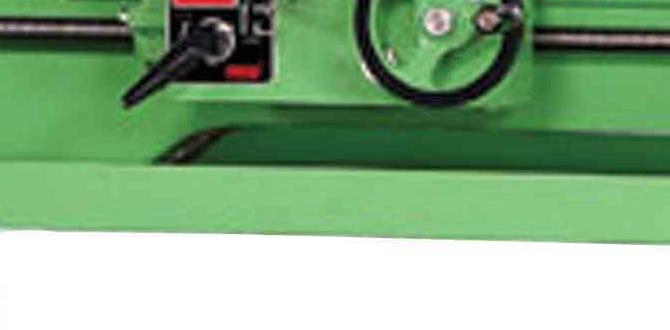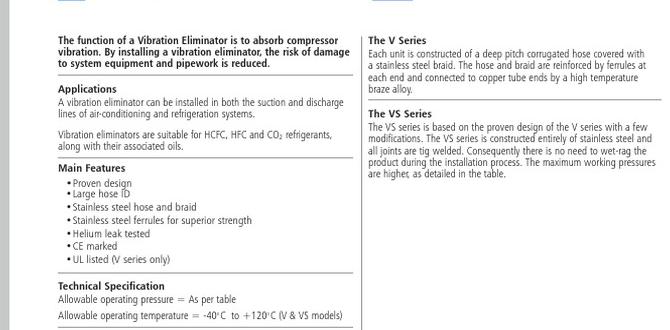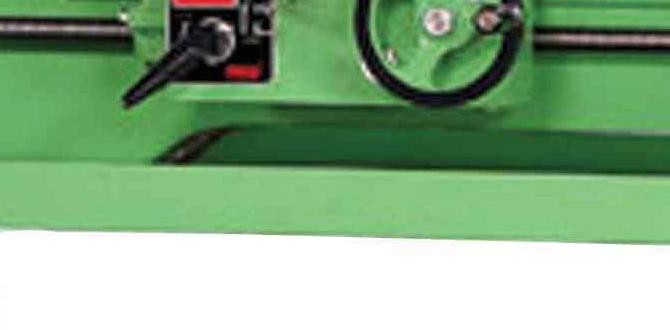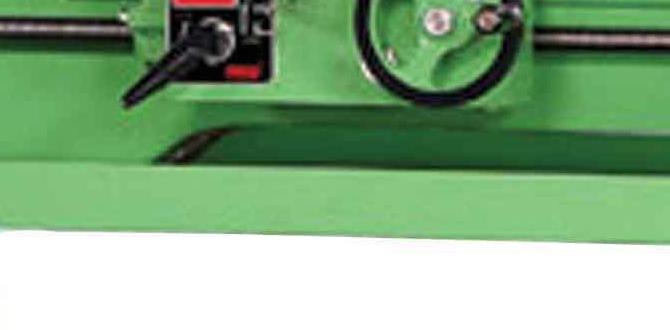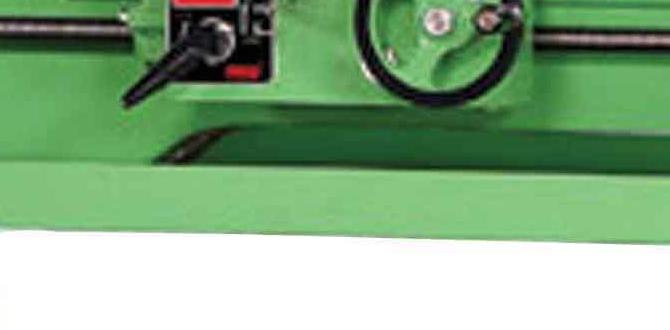Get your wood lathe tools razor-sharp by avoiding common sharpening blunders. This guide reveals essential tips to ensure perfect edges, better cuts, and longer tool life for consistent, beautiful woodworking results.
Ever been frustrated by a dull wood lathe tool that just won’t cut cleanly? You’re not alone. It’s a common stumbling block for many woodturners, and often, the culprit isn’t the tool itself, but how it’s being sharpened. Making small mistakes can lead to less-than-perfect finishes, harder work, and even damage to your tools. But don’t worry! Learning to sharpen your tools correctly is a learnable skill, and with a little guidance, you can achieve that perfect, glass-smooth edge every time. This article breaks down the most common sharpening mistakes and gives you the proven steps to avoid them, transforming your turning experience from frustrating to fantastic.
Understanding Wood Lathe Tool Sharpening
Sharpening your wood lathe tools isn’t just about making them sharp; it’s about restoring their original cutting geometry. A properly sharpened tool glides through wood, leaving a clean surface that requires minimal sanding. A dull tool, on the other hand, tears at the wood fibers, demanding more force, leading to tear-out, and making your woodworking projects much harder than they need to be. The goal is to refine the edge without removing excessive metal or altering the tool’s intended shape.
Why Sharp Tools Matter
Sharp tools are the foundation of successful woodturning. They offer:
- Cleaner Cuts: Reduce tear-out and improve surface finish.
- Less Effort: Tools glide through wood, requiring less force.
- Improved Control: Predictable cuts mean better accuracy and safety.
- Tool Longevity: Proper sharpening removes minimal metal, extending the life of your tools.
- Safer Operation: Dull tools are more likely to catch or bounce, leading to accidents.
For beginners, mastering tool sharpening is perhaps the single most impactful skill to develop. It directly affects the quality of your work and your enjoyment of the turning process. Think of it as the bedrock of your lathe skills.
Common Wood Lathe Tool Sharpening Mistakes (And How to Avoid Them)
Many woodturners, especially those new to the craft, fall into a few common traps when it comes to sharpening. Identifying these mistakes is the first step to correcting them and achieving those coveted sharp edges. We’ll go through them one by one, offering simple solutions.
Mistake 1: Over-Grinding or Removing Too Much Metal
This is incredibly common, especially with powered grinding wheels. The temptation to “really get an edge on there” can lead to grinding away too much of the tool’s bevel. This not only shortens the life of your tool but can also change its fundamental shape and how it cuts.
How to Avoid It:
- Light Passes: Use light pressure and make short, controlled passes over the grinding wheel or sharpening stone.
- Cooling is Key: Dip your tool in water frequently to prevent overheating, which can draw the temper from the steel. A burnt edge is a ruined edge.
- Focus on the Angle: Concentrate on maintaining the correct bevel angle. You’re refining the edge, not reshaping the entire tool.
- Use a Magnifier: Inspect the edge as you go. You’ll see the wire edge forming without needing to grind for ages.
Mistake 2: Incorrect Bevel Angle
Every turning tool has an ideal bevel angle for specific tasks. Using an angle that’s too steep or too shallow will negatively impact its cutting performance and can lead to chatter or tear-out.
- Scrapers: Typically have a flat or slightly rounded bevel, around 45-60 degrees.
- Gouges (Bowl): Often sharpened around 30-45 degrees for aggressive cutting.
- Gouges (Spindle): May have slightly higher angles, around 40-50 degrees.
- Skew Tools: Require precise angles, often between 40-50 degrees, depending on the specific cut.
How to Avoid It:
- Know Your Tools: Understand the intended use of each tool and its recommended bevel angle.
- Use Angle Guides: Many sharpening systems and jigs have built-in angle guides.
- Practice: Sharpening jigs can be your best friend here. They hold the tool at a consistent angle while you grind or hone. For example, a simple jig can help maintain the correct bevel on your bowl gouge.
- Mark the Bevel: You can use a marker to color the bevel face. When you lightly touch the sharpening stone, the marker will be removed from the areas that are making contact. This helps you see if you’re hitting the entire bevel consistently.
Mistake 3: Not Establishing a Consistent Bevel
Even if you have the right angle, if the bevel isn’t consistent along the entire cutting edge, the tool won’t cut cleanly. This often happens with freehand sharpening.
How to Avoid It:
- Use a Jig: A sharpening jig is invaluable for maintaining that consistent angle. It ensures the tool is presented to the abrasive at the same angle with every stroke.
- Smooth, Steady Strokes: If sharpening freehand, use long, sweeping strokes that cover the entire bevel.
- Listen and Feel: Develop a feel for how the tool is contacting the abrasive. You should feel a consistent drag.
Mistake 4: Forgetting the Secondary Bevel (Honing)
After grinding to refine the primary bevel, a secondary bevel (a microbevel) is crucial for a truly sharp edge. This is a much smaller, steeper angle at the very apex of the cutting edge, created by honing. Skipping this step leaves a toothy, less refined edge.
How to Avoid It:
- Stone Progression: Move from coarser to finer sharpening stones or abrasives.
- Honing Angle: Set your jig or freehand for a slightly steeper angle than your primary bevel (often just 2-5 degrees steeper). This creates a narrow, highly refined secondary bevel.
- Light Pressure: Honing requires very light pressure. You’re polishing the edge, not grinding it.
- Leather Strop: For the ultimate keen edge, use a leather strop charged with a fine abrasive compound. This polishes out any microscopic imperfections.
Mistake 5: Uneven Grinding or Sharpening
This results in a cutting edge that isn’t straight across. One side might be sharper than the other, or the edge might be wavy. This leads to a poor finish and an unpredictable cut.
How to Avoid It:
- Center the Tool: Ensure the center of the tool’s cutting edge is in proper contact with the abrasive.
- Even Strokes: Use consistent strokes that move from one side of the edge to the other smoothly.
- Jigs are Your Friend: Again, jigs are excellent for ensuring even contact and consistent angles across the entire edge.
- Visual Inspection: Regularly check the edge for evenness under good light.
Mistake 6: Overheating the Tool Steel
Grinding too aggressively or for too long without cooling can heat the tool’s cutting edge past its tempering temperature. This softens the steel, destroying its ability to hold an edge. You’ll notice a change in color (often a straw or blue tint) if it gets too hot.
How to Avoid It:
- Frequent Dips: Keep a bowl of water nearby and dip the tool into it often – every few seconds of grinding.
- Light Pressure: Let the abrasive do the work. Don’t force the tool into the grinding wheel.
- Short Grinding Sessions: Grind for a few seconds, then cool. Repeat.
- Slow Speed Grinders: Consider using a slow-speed grinder if possible. They generate less heat. For more on abrasive technologies, check out resources from organizations like the National Institute of Standards and Technology (NIST) which discusses the science behind abrasive processes.
Mistake 7: Not Sharpening Often Enough
This might seem counterintuitive, but waiting until a tool is completely dull makes sharpening much harder and requires removing more metal. A tool that starts to feel like it’s “rubbing” rather than cutting needs attention.
How to Avoid It:
- Sharpen as Needed: Get into the habit of touching up your tools frequently. A quick touch-up on a fine stone or strop can restore an edge quickly.
- Sharpen Between Projects: Make it a routine to sharpen your primary tools after a large project or before starting a new one.
- Listen to Your Tool: Your tool will tell you when it’s getting dull through the sound and feel of the cut.
Mistake 8: Using the Wrong Sharpening Abrasives
There’s a wide range of abrasives available, from coarse grinding wheels to ultra-fine diamond plates and water stones. Using an abrasive that’s too coarse for touch-ups or too fine for initial grinding will be inefficient or ineffective.
How to Avoid It:
- Understand Grit: Coarse grits (e.g., 120-220) are for establishing bevels when a tool is significantly dull or damaged. Medium grits (e.g., 400-800) are for general sharpening. Fine grits (e.g., 1000+) and strops are for honing and achieving a razor edge.
- Diamond vs. Stone vs. Belt: Each has strengths. Diamond plates are durable and fast but can wear at a tool’s edge if not used carefully. Water stones offer a superior cutting action and finish but require maintenance. Sharpening belts on a dedicated machine can be very fast and effective.
- Match Abrasive to Tool: For most HSS (High-Speed Steel) lathe tools, diamond plates, quality water stones (like Shapton, Naniwa, or Norton), or ceramic sharpening systems are excellent choices.
- Check Manufacturer Recommendations: Some tool manufacturers offer guidance on best practices for sharpening their specific steels.
Mistake 9: Not Sharpening to a True Cutting Edge
A “sharp” tool isn’t just one that feels keen to your finger. It’s a tool with a microscopic, burr-free apex that can slice wood fibers cleanly. Many beginners stop at the grinding stage without adequate honing, leaving a slightly burred or toothy edge.
How to Avoid It:
- The “Wire Edge” Test: After grinding, there should be a tiny, often visible or easily felt “wire edge” or burr on the opposite side of the bevel. This indicates you’ve ground to the apex.
- Honing Removes the Burr: Honing and stropping are then used to remove this wire edge and refine the apex into a keen, smooth cutting edge.
- The Paper Cut Test: A properly sharpened tool should shave paper easily and cleanly, without snagging or tearing.
- Leather Strop is Key: Don’t underestimate the power of a leather strop with a polishing compound. It’s essential for that final, clean edge.
Mistake 10: Sharpening at the Wrong Speed (for Grinders)
When using powered grinding wheels, the speed matters. Too fast a speed generates more heat. While some professionals use high-speed grinders with careful technique, beginners often benefit from slower speeds.
How to Avoid It:
- Slow Speed Grinders (1700-2000 RPM): These are ideal for woodworking tools. They generate significantly less heat, making it easier to avoid burning the tool.
- If Using High Speed (3450 RPM): Be extremely judicious with pressure and cooling. Dip your tool in water more frequently.
- Water-Cooled Grinders: Systems like Scarlett or Tormek use a slow-speed wheel that runs through water, providing constant cooling and a very fine honing action.
Essential Sharpening Tools & Setup
To avoid these mistakes, having the right tools and a good setup is vital. Here’s a basic rundown:
Essential Tools for Sharpening
- Sharpening Jigs: Crucial for maintaining consistent bevel angles. Examples include Diamond Turning Tools’ jigs or similar universal holders.
- Sharpening Stones: A selection of grits is necessary, from medium (400-600) to fine (1000-2000) and extra-fine (3000-8000) for honing. Water stones, oil stones, or diamond plates work well.
- Leather Strop: A leather belt or bench-mounted strop, charged with honing compound.
- Water Container: For cooling your tools during grinding.
- Magnifying Glass: To inspect the edge.
- Safety Glasses: Always wear eye protection.
Recommended Sharpening Systems
While you can sharpen freehand, using a system greatly increases consistency:
| System Type | Pros | Cons | Best For |
|---|---|---|---|
| Bench Grinders (Slow Speed) | Less heat generation, good for establishing bevels. | Can still overheat if not careful, requires consistent jig use. | Beginners establishing primary bevels. |
| Water Stones (e.g., Naniwa, Shapton) | Excellent feedback, produce a very keen edge, self-sharpening. | Require flattening, can be slower than diamond, can be messy. | Achieving a refined edge, all skill levels. |
| Diamond Plates (e.g., DMT, Grits from course to fine) | Fast cutting, durable, no flattening needed, work wet or dry. | Can put tiny scratches on the edge if not careful, can be expensive. | Quick sharpening and touch-ups, all skill levels. |
| Dedicated Sharpening Machines (e.g., Tormek) | Extremely consistent, excellent cooling, easy to use jigs. | High cost, takes up space, can be slow for heavy grinding. | Woodworkers at all levels, especially those who value consistency and ease. |
Step-by-Step Sharpening Process (Avoiding Mistakes)
Let’s walk through a simplified sharpening process for a common tool, like a bowl gouge, incorporating the lessons learned about avoiding mistakes. Always prioritize safety – wear safety glasses!
Step 1: Prepare Your Station
Set up your sharpening system within easy reach. Have your water bath, any necessary jigs, and your progression of stones ready. Ensure good lighting.
Step 2: Establish the Primary Bevel (Grinding)
Use a sharpening jig to hold your bowl gouge. Set the jig so the flute aligns with the cutter’s intended bevel angle (typically 30-45 degrees for a bowl gouge). Let’s say you’re using a grinding wheel. Lightly touch the bevel to the spinning wheel, moving the tool from side to side to ensure even contact. Grind for just a few seconds at a time, lifting and dipping the tool’s cutting end in your water bath to cool it. Repeat this process, making sure you are grinding both sides of the bevel evenly and that the bevel surfaces are consistent.
Mistake to Avoid: Overheating, uneven pressure, grinding too much metal.
Step 3: Check for a Wire Edge
After a few passes, carefully feel the edge on the side opposite the bevel. You should feel a very fine, slightly rough edge – the wire edge or burr. This indicates you’ve ground to the apex. If you don’t feel one, continue with light passes, cooling frequently.
Step 4: Refine the Bevel (Sharpening Stones)
Move to your sharpening stones. Start with a medium grit stone (e.g., 400-600). Place the gouge in its jig or hold it freehand, maintaining the tool’s primary bevel angle. Use smooth, consistent strokes across the stone, working to remove the grind marks and refine the edge. This is where consistency in angle is paramount to avoid those dreaded uneven edges.
Mistake to Avoid:

